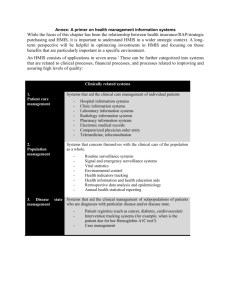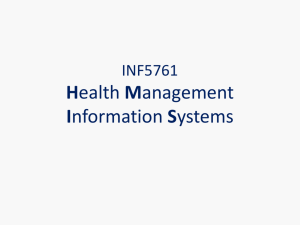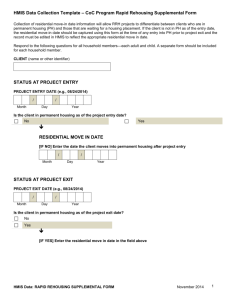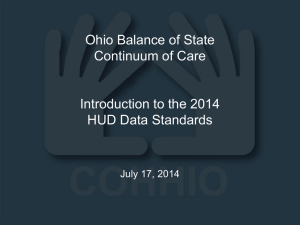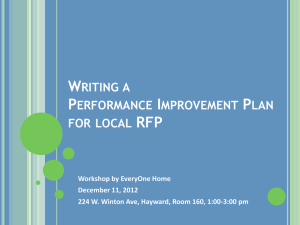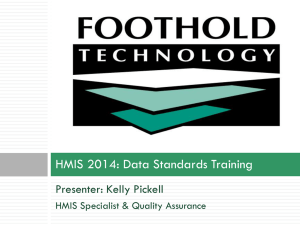Hmis 101 HMIS System administrator training series
advertisement
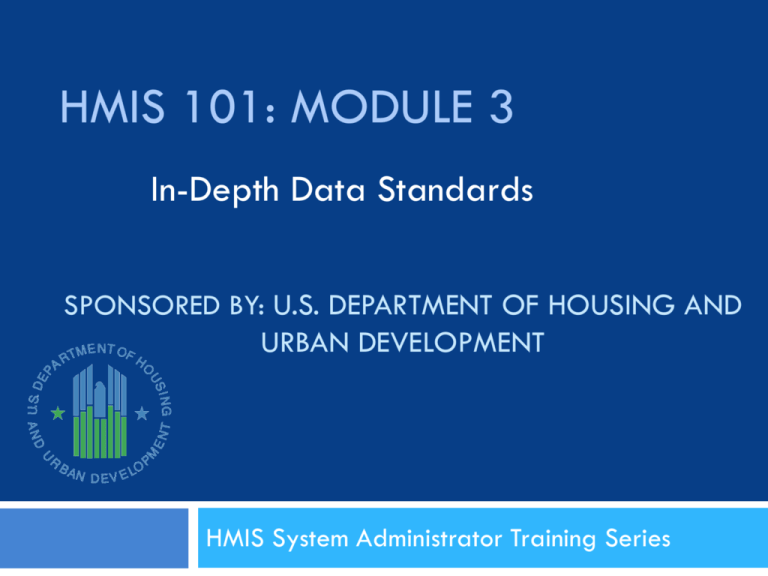
HMIS 101: MODULE 3 In-Depth Data Standards SPONSORED BY: U.S. DEPARTMENT OF HOUSING AND URBAN DEVELOPMENT HMIS System Administrator Training Series Partners 2 Jeff Ward, Abt Associates, Inc. Kat Freeman, The Cloudburst Group Natalie Matthews, Abt Associates, Inc. Chris Pitcher, The Cloudburst Group Purpose 3 Provide HMIS System Administrators, end users, CoC representatives, consumers, and federal, state, and local partners with a basic understanding of: HMIS Data Standards Webinar Format 4 This training is part of a series of trainings that will provide new staff with the basic information needed to operate or participate in an HMIS It is anticipated that this series of trainings will be offered quarterly This training is anticipated to last 90 minutes Presenters will walk through presentation material Audience members are “muted” due to the high number of participants Submitting Questions 5 All follow-up questions should be submitted to the Ask the Expert function on www.hmis.info If you have multiple questions, we recommend compiling them into a single submission to Ask the Expert with a reference to the HMIS 101: Module 3 training Webinar Materials & Evaluation 6 Quick follow up survey will be emailed out after the webinar The webinar will be recorded, and all materials will be posted to HMIS.info During webinar, we’ll be asking you a few questions as well Overview of Training Series 7 HMIS 101 Modules III, IV and V: Module III: In-Depth Data Standards Module IV: In-Depth Security and Privacy Module V: Data Quality Standard and Compliance Plans HMIS 201: HMIS Budgeting and Staffing PIT and HIC Best Practice Highlights/ Use of Technology Poll #1: Role with HMIS 8 A. B. C. D. E. F. HMIS System Administrator HMIS Data Entry staff/Program staff CoC staff Technical Assistance provider/Trainer HMIS Vendor Other 9 Introduction to Standards History of HMIS Standards 10 HMIS Data Standards were developed by focus groups of community stakeholders, researchers, technology experts and consumers Data and Technical Standards were initially published in July 2004 Sections 2 and 3 of the original standard were replaced in March 2010 while the remaining sections of the 2004 standard remain in effect Focused on standards, not development of a system History of HMIS Standards 11 What the HMIS Standards Don’t Do: Set a specific software to be used Limit a CoC or HMIS from requiring the collection additional data elements Limit a CoC or HMIS from requiring additional client privacy and system security protections Limit a CoC or HMIS from adding additional functionality (beyond HUD purposes) Stay static (they are updated periodically) HMIS Data Standards 12 There are 3 data element categories outlined in the March 2010 Revised HMIS Data Standards Program Descriptor Data Elements (PDDE) Universal Data Elements (UDE) Program-Specific Data Elements (PSDE) The Data Standards define specific, allowable responses for each data element Not all the data in the Data Standard are required to be collected by every program Each program will collect at least a subset of data Poll #2: HMIS Data Standards 13 True or False: The HMIS Data and Technical Standards are a document that outlines the data collection, privacy, and security requirements for collecting data required by HUD. 14 Poll #3: How categories of Data Elements? A. B. C. D. E. One Two Three Four Unsure—didn’t cover 15 Program Descriptor Data Elements Program Descriptor Data Elements 16 Establish program hierarchy using: 2.1 2.2 2.3 2.4 2.5 Organization Identifier Organization Name Program Identifier Program Name Direct Service Code Example 17 Program Descriptor Data Elements 18 2.6 Site Information Program Site Configuration Type Site Address Geocode Site Type Housing Type This information is collected at the program and site level. Program Descriptor Data Elements 19 Program Site Configuration Type Single site, single building Single site, multiple buildings Multiple sites Site Address EXCEPTION: Victim Service Providers address list administrative office address (no shelter address) Mobile and scattered site programs should record the address of their administrative office Geocode Scattered site should record for the location of the majority of their beds or where the beds were located as of the last HIC update. Program Descriptor Data Elements 20 Site Type Non-Residential: Services Only Residential: special needs and non-special needs Residential: special needs only Housing Type Mass shelter/ Barracks Dormitory/hotel/motel Shared housing Single Room Occupancy (SRO) Single Apartment (non-SRO) Single Home/townhouse/duplex Not Applicable: non-residential program Program Descriptor Data Elements 21 2.7 Continuum of Care Number 2.8 Program Type Code Emergency Shelter Transitional Housing Permanent Supportive Housing Homeless Outreach Homeless Prevention and Rapid Re-housing Services Only Program Other Safe Haven Permanent Housing (e.g., Mod Rehab SRO, subsidized housing without services) Program Descriptor Data Elements 22 2.9 Bed and Unit Inventory Information Household Type Bed Type Availability Bed Inventory CH Bed Inventory (PSH Only) Unit Inventory Inventory Start Date Inventory End Date HMIS Participating Beds HMIS Participation Start Date HMIS Participation End Date Program Descriptor Data Elements 23 Bed and Unit Inventory Information Household Type Bed Type Facility-based Voucher Other Availability Households without Children Households with Children Year-round Seasonal (Emergency Shelters Only) Overflow (Emergency Shelters Only) Bed Inventory CH Bed Inventory (PSH Only) Unit Inventory Program Descriptor Data Elements 24 Bed and Unit Inventory Information (cont’d) Inventory The date the bed/unit inventory was made available Inventory The HMIS Start Date End Date date the bed/unit inventory was no longer available Participating Beds HMIS Participation Start Date HMIS Participation End Date Program Descriptor Data Elements 25 2.10 Target Population A Single Males (18 years or older) Single Females (18 or older) Single Males and Females (18 or older) Couple Only, No Children Single Males and Households with Children Single Females and Households with Children Households with Children Unaccompanied Young Males (under 18) Unaccompanied Young Females (under 18) Unaccompanied Young Males & Females (under 18) Single Male and Female & Households with Children Program Descriptor Data Elements 26 2.11 Target Population B DV: Domestic Violence victims VET: Veterans HIV: Persons with HIV/AIDS NA: Not Applicable 2.12 Method for Tracking Residential Program Occupancy Program Entry and Exit Date Comparison Bed Management Model Service Transaction Model 2.13 Grantee Identifier Poll #4: Program Descriptors 27 Why do program descriptor data elements matter? A. B. C. D. They don’t—they’re optional They establish the hierarchy of programs within an organization in the HMIS and uniquely identify Organizations and their programs. They also identify whether or not, within the electronic HMIS system, programs are organizational names only OR do the programs provide direct services. Both B and C 28 Universal Data Elements Universal Data Elements 29 3.1 Name 3.9 Residence Prior to 3.2 Social Security Number Program Entry 3.10 Zip Code of Last 3.3 Date of Birth Permanent Address 3.4 Race 3.11 Housing Status 3.5 Ethnicity 3.12 Program Entry Date 3.6 Gender 3.13 Program Exit Date 3.7 Veteran Status 3.8 Disabling Condition 3.14 Unique Person Identification Number 3.15 Household Identification Number Universal Data Elements 30 • 3.1 Name – The First, Middle, Last and suffix of the client’s name – Collected at program entry or as soon as possible thereafter • 3.2 Social Security Number – Importance – Unique ID creation – Facilitate an increase in mainstream resource utilization – SSN Type component for assessing data quality – Full SSN Reported – Partial SSN reported – Don’t Know/ Doesn’t have SSN – Refused Universal Data Elements 31 • 3.3 Date of Birth – Date of Birth Type component for assessing data quality • Full DOB Reported • Approximate or Partial DOB Report • Don’t Know • Refused • 3.4 Race – American Indian or Alaska Native – Asian – Black or African American – Native Hawaiian or Other Pacific Islander – White – Don’t Know – Refused Universal Data Elements 32 3.5 Ethnicity Non-Hispanic/Latino Hispanic/Latino Don’t Know/Refused 3.6 Gender Female Male Transgendered Male to Female Transgendered Female to Male Other Don’t Know/ Refused 3.7 Veteran Status Yes No Don’t Know/Refused Universal Data Elements 33 3.8 Disabling Condition Must now be collected for all clients served 3.9 Residence Prior to Program Entry Tenure and Housing Subsidy incorporated into response values Added Response Values: Safe Haven Rental by client, with VASH housing subsidy Rental by client, with other (non-VASH) ongoing housing subsidy Owned by client, with ongoing housing subsidy Rental by client, no ongoing housing subsidy Owned by client, no ongoing housing subsidy Don’t Know and Refused Universal Data Elements 34 3.10 Zip Code of Last Permanent Address Change in wording to response value 3.11 Housing Status Response values: Literally Homeless Imminently losing their housing Unstably housed or at-risk of losing their housing Stably Housed Don’t Know and Refused Universal Data Elements 35 3.12 Program Entry Date Special Issues section -- suggested models for noting and tracking supportive services received by the client prior to program entry: Service Transaction Model Separate Program Model 36 Program Specific Data Elements Program-Specific Data Elements 37 4.1 Income and Sources Frequency of Collection Program Entry Program Exit Annually General question Income Receipt in last 30 days, Y/N Dollar amount of earned income is required Dollar amount of other income is optional Total Income is still required Program-Specific Data Elements 38 4.2 Non-Cash Benefits Frequency of Collection Program Entry Program Exit Annually Subject Scope General question Non-Cash Benefit Receipt in last 30 days, Y/N Response values Clarification: #12 clarified regarding ongoing rental assistance Added: Temporary Rental Assistance Program-Specific Data Elements 39 4.3 Physical Disability 4.4 Developmental Disability 4.6 HIV/AIDS 4.7 Mental Health 4.8 Substance Abuse New Component Currently Receiving services or treatment Frequency of Collection Program Entry Program Exit Annually Subject Scope Response values Added: “Don’t Know” and “Refused” Program-Specific Data Elements 40 4.5 Chronic Health Condition New Data Element Does the client have Currently Receiving services or treatment Frequency of Collection Program Entry Program Exit Annually Subject Scope All Clients Served Response values “No”, “Yes”, “Don’t Know” and “Refused” Program-Specific Data Elements 41 4.3 Physical Disability 4.4 Developmental Disability 4.5 Chronic Health Condition 4.7 Mental Health SPECIAL ISSUE!! If response to these data elements is “Yes”, then the case manager must document the condition. Documentation includes written verification from a statelicensed professional, such as a medical service provider or a health-care provider, the Social Security Administration, or the receipt of a disability check (i.e. SSDI Check or VA disability benefit check). Program-Specific Data Elements 42 4.9 Domestic Violence Added “Don’t Know” and “Refused” 4.10 Destination Tenure and Housing Subsidy incorporated into response values Added Response Values: Safe Haven Rental by client, with VASH housing subsidy Rental by client, with other (non-VASH) ongoing housing subsidy Owned by client, with ongoing housing subsidy Deceased Don’t Know and Refused Changed: “Room, apartment, or house that you rent” to “Rental by client, no ongoing housing subsidy” “Apartment or house that you own” to “Owned by client, no ongoing housing subsidy” Program-Specific Data Elements 43 4.11 Date of Contact Date, with Time Stamp Location of Contact Place Not Meant for Habitation Service Setting, Non-Residential Service Setting, Residential 4.12 Date of Engagement Date, with Time Stamp Program-Specific Data Elements 44 4.13 Financial Assistance Provided Start Date of Financial Assistance End Date of Financial Assistance Financial Assistance Type Rental assistance Security deposits Utility deposits Utility payments Moving cost assistance Motel & hotel vouchers Financial Assistance Amount Program-Specific Data Elements 45 4.14 Housing Relocation & Stabilization Services Provided Start Date of Service End Date of Service Type(s) of Service Case Management Outreach and Engagement Housing search and placement Legal Services Credit Repair Program-Specific Data Elements 46 4.15 Optional Data Elements Employment Adult Education General Health Status Pregnancy Status Veteran’s Information Children’s Education Reason for Leaving Services Provided Poll #5: Program Specific 47 Which HUD report requires that programs collect all three categories of data elements, including the Program Specific, on clients served by their program? Annual Homeless Assessment Report Annual Progress Report Annual Performance Report Housing Inventory Count 48 Next Steps and Resources Next Webinar: Module 4 49 Friday, August 19th, 2011from 3:00pm4:30pm(EST): Separate registration is required Topics to be covered: In-Depth Security and Privacy Resources 50 HMIS Data Standards (March 2010): http://www.hmis.info/ClassicAsp/documents/Final%20HMIS%2 0Data%20Standards-Revised%20_3.pdf www.hmis.info HUD Homelessness Resource Exchange: www.hudhre.info Data Quality Plan Toolkit: http://www.hudhre.info/documents/HUDDataQualityTo olkit.pdf 51 Thank you!
